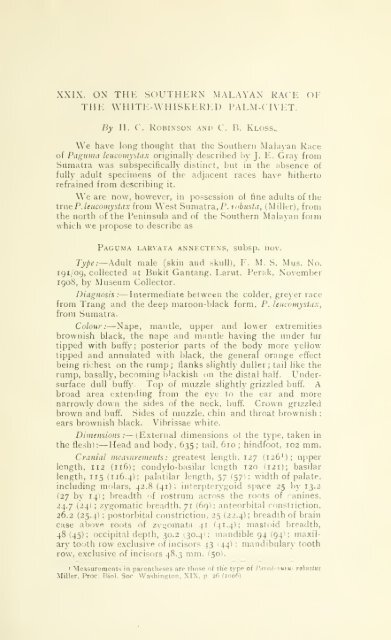Journal of the Federated Malay States museums - Sabrizain.org
Journal of the Federated Malay States museums - Sabrizain.org
Journal of the Federated Malay States museums - Sabrizain.org
Create successful ePaper yourself
Turn your PDF publications into a flip-book with our unique Google optimized e-Paper software.
XXIX. ON THE SOUTHERN MALAYAN RACE OF<br />
THE WHITE-WHISKERED PALM-CIVET.<br />
By II. C. Robinson and C. B. Kloss.<br />
We have long thought that <strong>the</strong> Sou<strong>the</strong>rn <strong>Malay</strong>an Race<br />
ol Paguma leucomystax originally described by J. E. Gray from<br />
Sumatra was subspecifically distinct, but in <strong>the</strong> absence <strong>of</strong><br />
fully adult specimens <strong>of</strong> <strong>the</strong> adjacent races have hi<strong>the</strong>rto<br />
refrained from describing it.<br />
We are now, however, in possession <strong>of</strong> fine adults <strong>of</strong> <strong>the</strong><br />
true P. leucomystax from West Sumatra, 7'. robusta, (Miller), from<br />
<strong>the</strong> north <strong>of</strong> <strong>the</strong> Peninsula and <strong>of</strong> <strong>the</strong> Sou<strong>the</strong>rn <strong>Malay</strong>an form<br />
which we propose to describe as<br />
Paguma larvata annectens, subsp. nov.<br />
Type:—Adult male (skin and skull), F. M. S. Mus. No.<br />
191/09, collected at Bukit Gantang, Larut, Perak, November<br />
1908, by Museum Collector.<br />
Diagnosis:— Intermediate between <strong>the</strong> colder, greyer race<br />
from Trang and <strong>the</strong> deep maroon-black form, /'. leucomystax,<br />
from Sumatra.<br />
Colour .-—Nape, mantle, upper and lower extremities<br />
brownish black, <strong>the</strong> nape and mantle having <strong>the</strong> under fur<br />
tipped with buffy; posterior parts <strong>of</strong> <strong>the</strong> body more yellow<br />
tipped and annulated with black, <strong>the</strong> general orange effect<br />
being richest on <strong>the</strong> rump; Hanks slightly duller; tail like <strong>the</strong><br />
rump, basally, becoming blackish on <strong>the</strong> distal half. Undersurface<br />
dull buffy. Top <strong>of</strong> muzzle slightly grizzled buff. A<br />
broad area extending from <strong>the</strong> eye to <strong>the</strong> car and more<br />
narrowly down <strong>the</strong> sides <strong>of</strong> <strong>the</strong> neck, buff. Crown grizzled<br />
brown and buff. Sides <strong>of</strong> muzzle, chin and throat brownish ;<br />
ears brownish black. Vibrissae white.<br />
Dimensions :— (External dimensions oi <strong>the</strong> type, taken in<br />
<strong>the</strong> flesh):— Head and body, 635; tail, 610 ; hindfoot, 102 mm.<br />
Cranial measurements: greatest length. 127 (126 1<br />
); upper<br />
length, 112 (116); condylo-basilar length 120 (121); basilai<br />
length, T15 1 1 ib..}): palatilar length. 57 (57); width <strong>of</strong> palate,<br />
including molars, 42.8(41); interpterygoid space 25 by 13.2<br />
127 by !(•: breadth <strong>of</strong> rostrum across <strong>the</strong> roots <strong>of</strong> canines,<br />
breadth, 71 (69); anteorbital cm strict ion,<br />
24.7 1241 ; zygomatic<br />
26.2 (25.4) ; postorbital constriction. 25 (22.4) ; breadth <strong>of</strong> brain<br />
case above roots <strong>of</strong>. zygomata 4 1 (41.4); mastoid breadth,<br />
48(45); occipital depth, 30.2 (30.4); mandible 94 (94); maxilarv<br />
tooth row exclusive 1 <strong>of</strong> incisors |? (4) : mandibulary tooth<br />
row, exclusive <strong>of</strong> incisors 48.3 mm. (50).<br />
' Measurements in paren<strong>the</strong>ses are tlm .< > '""is robustus<br />
Miller. Proc. Biol. Sor Washington, XIX. p 26 (1006).
















